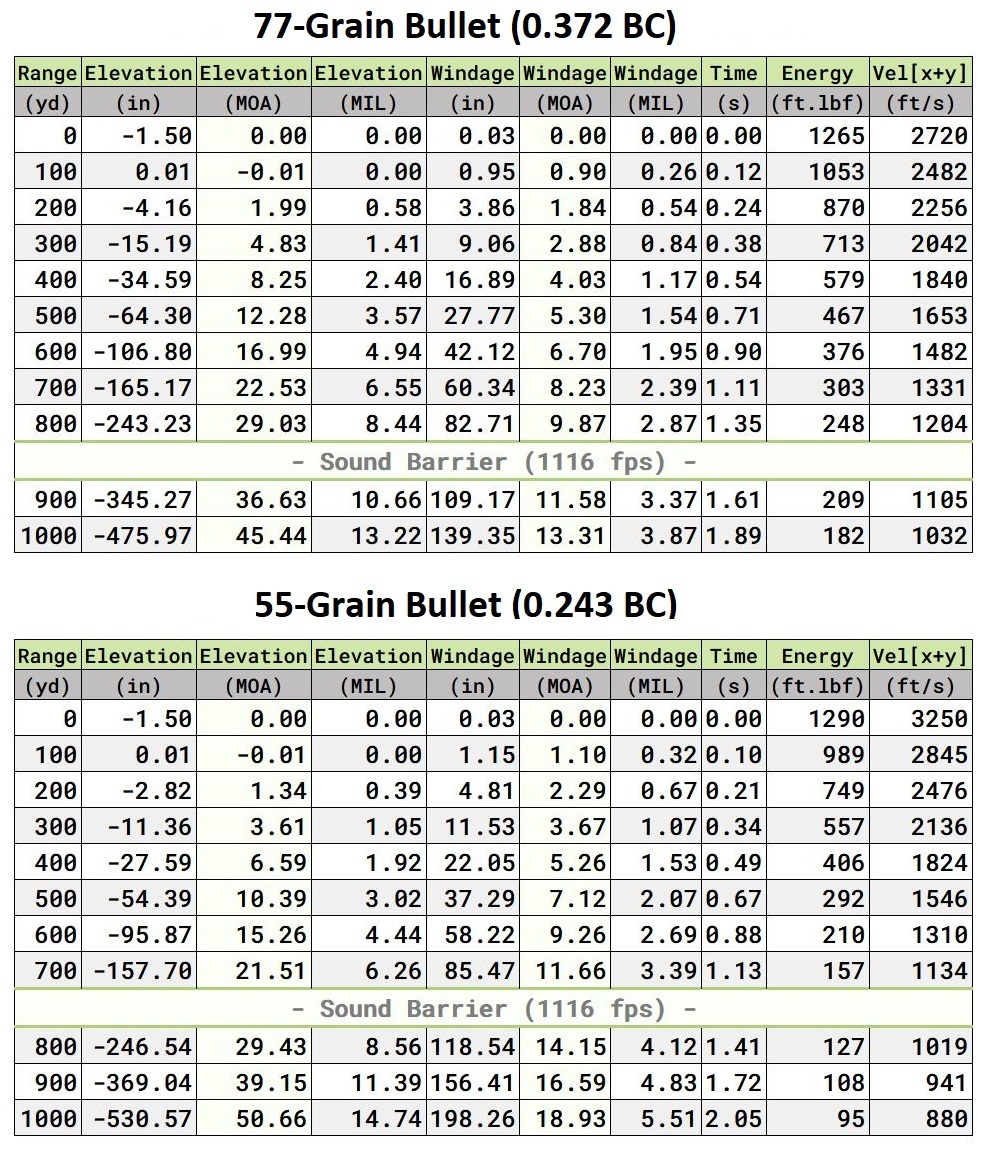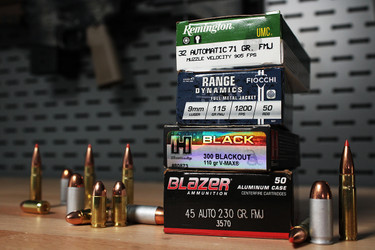What is Bullet Grain Weight? How it Affects Accuracy
Posted by Gunbuilders.com on Jul 7th 2025
You see it every time you buy ammo: "55-grain 5.56 NATO," or, "147-grain 9mm." What does "grain" even mean? How does it affect accuracy, takedown power, and overall performance? When should you opt for heavier or lighter grain weights? Here are all the answers.
What is Bullet Grain Weight?
If you thought of agriculture when you first saw the phrase "grain weight" while shopping for ammo, well, you were correct: The grain weight of a bullet is based on ancient measuring methods, when grains of wheat were used to balance apothecaries' scales against the weight of their goods sold, like herbs, teas, and spices.
So, yes: The grain weight of a bullet is simply the projectile's weight, measured in wheat grains. The higher the grain weight, the heavier the bullet.
Grain weight does not refer to grains of gunpowder. Gunpowder is also measured in grains, but this is separate and distinct from the grain weight of a bullet.
Why is Grain Weight Important?
The weight of your caliber's bullet directly impacts all aspects of its performance, including its velocity, power, accuracy, maximum effective distance, and felt recoil.
Heavier Bullets Produce More Felt Recoil
The energy of a bullet is calculated by multiplying its mass by its velocity. The heavier a bullet, the more mass it contains. So, heavier bullets produce more energy.
Because of Newton's Third Law ("for every action, there is an equal and opposite reaction") the more energy a bullet produces at the muzzle, the more felt recoil the shooter experiences.
Lighter Bullets Shoot Faster and Straighter
Because lighter bullets have less mass, it takes less energy to make them travel downrange. Since a caliber's casing has a fixed capacity when it comes to its gunpowder charge, lighter bullets will produce greater muzzle velocities than heavier bullets.
That increased velocity directly translates into less bullet drop, which makes it easier to match your point of impact with your point of aim.
Heavier Bullets Drop Faster (But They're More Accurate)
You might think lighter bullets are more accurate because they fly faster and suffer less bullet drop, but this isn't universally true.
At shorter distances, it is true that lighter bullets travel in a straighter line, which makes it easier to hit a target. And it is true that heavier bullets suffer more bullet drop across all distances.
But as distances increase, heavier bullets have more predictable flight paths, especially in windy conditions.
This is because heavier bullets have greater sectional densities. Sectional density refers to how much mass is contained within a bullet, and it's used to calculate ballistic coefficient. Abbreviated "BC," this is a technical term for describing a bullet's accuracy. The heavier a bullet is, the greater its ballistic coefficient, and the more accurate it is.
This is why, for example, shooters who want to maximize their AR-15's accuracy choose heavier 77-grain bullets over the more common 55- and 62-grain bullets. Those lighter bullets are less dense and have smaller ballistic coefficients, so they're more effected by air and wind resistance in flight.
Heavier Bullets Retain More Power Downrange
If takedown power is your primary concern, heavier bullets are more effective than lighter ones. Remember that heavier bullets generally produce more muzzle energy, and their greater sectional densities mean that they retain more of that energy as they travel downrange.
Taking the same example from above, we can compare the ballistics of 77-grain and 55-grain .223 bullets:

We can see from the data that the 77-grain bullet produces nearly the same muzzle energy as the 55-grain load offering 1,265 ft.-lbs. of muzzle energy against the lighter bullet's 1,290 ft.-lbs. of energy. As both rounds travel downrange, the 77-grain bullet's higher ballistic coefficient (0.372) allows it to retain a far greater portion of its muzzle energy than the 55-grain bullet, which suffers from a much smaller ballistic coefficient (0.243) due to its lighter grain weight.
By the time both bullets travel 500 yards, the 77-grain bullet retains 467 ft.-lbs. of energy; that's 37% of its muzzle energy. The 55-grain bullet retains just 292 ft.-lbs. of energy; that's 22% of its muzzle energy. We can also see the 77-grain bullet retains more velocity by the time both rounds reach 500 yards. Retaining more velocity and energy at distance means more accuracy and power, which illustrates the ballistic benefits of shooting heavier bullets when the goal is to maximize long-range performance.
What's Best for Home Defense?
Many will claim the extra muzzle energy of a heavier bullet is better for personal defense. But this doesn't take into account key factors, like over-penetration and felt recoil. Heavier bullets have more inertia, so they're more likely to penetrate barriers, walls, and other structures, which increases the risk of collateral damage and injury.
Heavier bullets also produce greater felt recoil, which can make it difficult to execute quick and accurate follow-up shots. At close distances, lighter bullets do not yield significantly less energy. Only at greater distances do the negative effects of a lower ballistic coefficient meaningfully contribute to less takedown power. Lighter bullets can still produce devastating wounds, particularly when chambering hollow-point ammo.
Given these factors, a lighter bullet is usually better for home defense.
What's Best for Target Shooting?
When target shooting, choosing light or heavy bullets depends entirely on the target's distance. If we again refer to our 77-grain and 55-grain .223 bullets' ballistic data, we can see the lighter bullet retains more velocity at up to 300 yards, and both rounds' velocities are roughly equal at 400 yards.
That means the lighter bullet suffers less bullet drop, making it easier to hit targets up to 300 yards away. The heavier 77-grain bullet is only the better choice for when engaging targets beyond 400 yards.
If you want to balance accuracy and bullet drop for a given caliber at any distance, simply pick a bullet with a middle-of-the-road grain weight for that caliber.
If you want to calculate the distances at which two bullets offer better performance, you can simply plug in those bullets' muzzle velocities, grain weights, and ballistic coefficients into a ballistic calculator (like the one we used, here).
What's Best for Long-Range Shooting?
The answer to this question is universal: Always choose the heaviest bullet for long-range shooting. The goal is to shoot bullets with the highest ballistic coefficients.
The highest-BC bullets offer the greatest hit probabilities because they retain the most muzzle velocity and energy downrange, so they suffer the least wind drift. This ultimately yields the most consistent points of impact relative to a single point of aim.
Greater bullet drop is not a concern in long-range shooting, because calculating the drop accurately all but guarantees a heavy bullet's high BC will make it land where it is expected.
DISCLAIMER: If you are new to the world of DIY gun building, you likely have a lot of questions and rightfully so. It’s an area that has a lot of questions that, without the correct answers, could have some serious implications. At GunBuilders.com, we are by no means providing this content on our website to serve as legal advice or legal counsel. We encourage each and every builder to perform their own research around their respective State laws as well as educating themselves on the Federal laws. When performing your own research, please be sure that you are getting your information from a reliable source.

